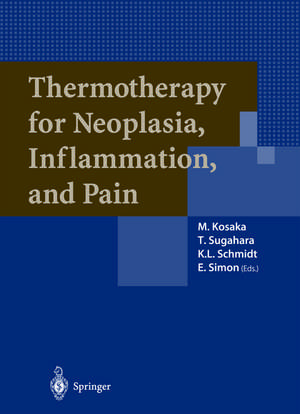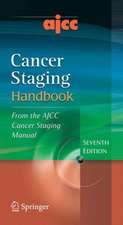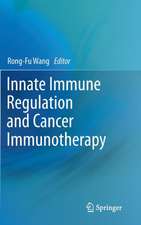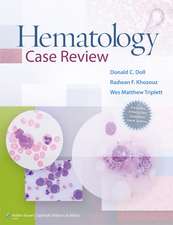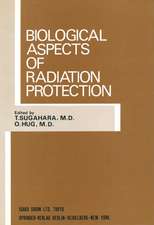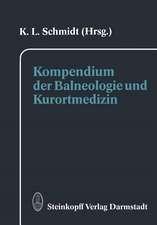Thermotherapy for Neoplasia, Inflammation, and Pain
Editat de M. Kosaka, T. Sugahara, K.L. Schmidt, E. Simonen Limba Engleză Paperback – 20 apr 2014
Preț: 749.37 lei
Preț vechi: 788.81 lei
-5% Nou
Puncte Express: 1124
Preț estimativ în valută:
143.41€ • 155.72$ • 120.46£
143.41€ • 155.72$ • 120.46£
Carte tipărită la comandă
Livrare economică 22 aprilie-06 mai
Preluare comenzi: 021 569.72.76
Specificații
ISBN-13: 9784431670377
ISBN-10: 4431670378
Pagini: 564
Ilustrații: X, 550 p. 113 illus., 3 illus. in color.
Dimensiuni: 210 x 279 x 30 mm
Greutate: 1.25 kg
Ediția:2001
Editura: Springer
Colecția Springer
Locul publicării:Tokyo, Japan
ISBN-10: 4431670378
Pagini: 564
Ilustrații: X, 550 p. 113 illus., 3 illus. in color.
Dimensiuni: 210 x 279 x 30 mm
Greutate: 1.25 kg
Ediția:2001
Editura: Springer
Colecția Springer
Locul publicării:Tokyo, Japan
Public țintă
ResearchCuprins
The Central Organization of the Thermoregulatory System.- Application of Heat and Cold: Physiological Responses and Therapeutic Implications.- Cerebral Regulation of Thirst.- Hypothalamic Neuroendocrine Responses to Cold and Dehydration Stress.- Differential Activation of Nitrergic Hypothalamic Neurons by Heat Exposure and Dehydration.- Thermoregulation as Survival Mechanism in Individuals and Species: Mutual Control of Body Temperature, Ingestion, and Reproduction in the Hypothalamus.- Merits of Diluted Sweat with Training on Arterial Pressure and Body Temperature Regulation in Heat Stress.- Thermal Stress and Water Supplementation.- Adaptive Changes in Sweat Gland Function.- Protective Measures Against Solar Radiant Heat and Ultraviolet Irradiation.- Central and Peripheral Control of Sweating Mechanisms: Modifications by Thermal Acclimatization and Physical Training.- Global Warming and Deaths from Heat Stroke.- Tackling Cold Stress.- Brown Adipose Tissue and Nonshivering Thermogenesis in Stressful States.- Diurnal and Seasonal Reactivity Patterns of Chemical Transmission in the Suprachiasmatic Nuclei and Other Brain Entities Related to Hibernation.- Induced Hypothermia in Cardiovascular and Brain Surgery.- Postanesthetic Shivering.- Sympathetic Adjustment of Cardiovascular Control and Thermoregulation in Humans Exposed to Heat Stress.- Muscle Sympathetic Nerve Activity During Acute Increase in Core Temperature in Humans.- Sympathetic Control of Sweating and Cutaneous Active Vasodilatation.- Lesions of the Central Nervous System and Sudomotor Impairments.- The Rat Tail as a Model Organ for Peripheral Vasodilation.- Concept of Selective Brain Cooling and Its Implication.- Selective Brain Cooling in Mammals: General and Regional Modes of Operation.- The Role of JuvenileThermoregulatory Thermogenesis in the Development of Normal Energy Balance or Obesity.- Endocrine Responses to Heat and Cold Stress.- Thermal Stress and Immunity.- Autonomic and Neuroendocrine Modulation of Cellular Immunity.- Exercise and Immunity.- Changes in Immune Activities by Heat Stress.- Autonomic and Endocrine Adjustments in Fever.- Adaptive Changes in the Sympathetic Nervous and Endocrine Systems During Fever Induced by Interleukin-1? in Conscious Rats: Potential Neural Mechanism.- Neuroanatomy of Fever: Localization of Cytokine and Prostaglandin Systems in the Brain.- Temperature Homeostasis and Redox Homeostasis.- Fever and Related Host Defense Responses.- Stress Response: Overview.- Induction of Heat-Shock Proteins and Their Biological Functions.- Fundamental Aspects of Hyperthermia on Cellular and Molecular Levels.- Learning from Bacteria: Molecular Chaperones in Ribosomes and Thermophilic Adaptation.- Molecular Chaperone and Folding: Lessons from Heat Shock Protein Research.- Modifications of Stress Response in Mammalian Cells Incubated at Low Temperature, Thermotolerant Cells, and Neuronal Cells During Differentiation.- Mammalian 105-kDa Heat-Shock Protein HSP105 and Its Biological Function.- Induction of Heat-Shock Proteins in Ischemic Heart and Myocardial Protection.- Theoretical and Experimental Basis of Hyperthermia.- Thermal Responses of Microcirculation and Modification of Tumor Blood Flow in Treating the Tumors.- Heat Inactivation of DNA-Dependent Protein Kinase: Possible Mechanism of Hyperthermic Radiosensitization.- Recent Aspects of Elucidating the Cellular Basis of Thermochemotherapy.- Effects of Hyperthermia-Induced Changes in pH Value on Tumor Response and Thermotolerance.- Enhancement of Hyperthermic Effects Using Rapid Heating.-Molecular and Cellular Factors Determining Cell Susceptibility to Heat Shock.- Enhancement of Cytotoxic Effects of Chemotherapeutic Agents with Hyperthermia In Vitro.- Radiofrequency Hyperthermia Alone in the Palliative Treatment of Mucinous Carcinomatosis: Optimizing and Monitoring Heat Delivery.- Cancer Gene Therapy in Conjunction with Hyperthermia Under the Control of Heat-Inducible Promoter.- Current Status of Clinical Hyperthermic Oncology in Japan.- Physiology and Psychology in Hyperthermic Oncology: Contribution of Clinical Oncologists in the Development of Heating of Deep-Seated Tumors.- Clinical Usefulness of Long-Term Thermohydrotherapy (Balneotherapy).- Combined Radon and Heat Exposure for Treatment of Rheumatic Diseases: A Clinical Approach.- Thermonociception: Sensory and Modulatory Mechanisms in Pathological Conditions.- Regulation of Efferent Functions of C-Fiber Nociceptors.- Pathogenesis and New Strategies in Rheumatoid Arthritis.- Thermotherapy of Pain, Trauma, and Inflammatory and Degenerative Rheumatic Diseases.
Caracteristici
A comprehensive overview of the physiology and cell biology of the therapeutic action of heating and
